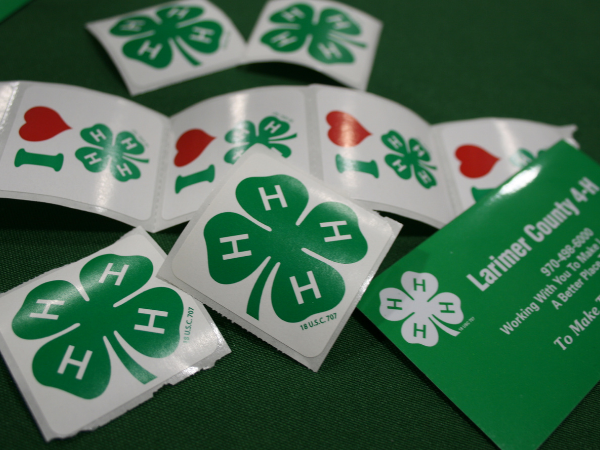Membership to 4-H is open to any youth who are age 8 – 18 by December 31st.
Children ages 5 – 7 can join the 4-H Cloverbud program, which is designed specifically for these ages.
Enrollment fees are $50*. Scholarships are available. This covers the manual and other costs associated with 4-H.
Some projects require the youth to have access to additional materials, supplies, or live animals. For example, livestock projects require youth to care for an animal that they purchase or lease. A sewing project will likely require that you have access to a sewing machine that you own or borrow. You may already have many or even all of the materials needed for some projects. If you see a project you are interested in, please feel free to contact us to see what materials are required. We can also provide resources/ tips for how/where to acquire materials at a discounted cost.
*Returning members are charged a late fee if they miss enrollment deadlines
Your participation type will depend on your age:
- “Cloverbuds” is for youth ages 5 to 7 as of December 31 of the current 4-H year
- 4-H members are 8 to 18 as of December 31 of the current 4-H year.
- College youth can also participate in Collegiate 4-H to help support 4-H youth.
- Pick your project(s). You can enroll in up to 5 projects for the $50 fee.
- Pick Your Club. Your club will be the group you regularly meet with. Clubs are lead by local volunteers who have been specially trained.
To begin your 4-H adventure, start looking at the at the many projects Larimer County offers. You may choose one or more projects from the project areas. There is a 4-H project for everyone! Projects are fun to do alone and with your friends.
Think about:
- An interest you’d like to explore
- A hobby you’d like to learn more about
- A topic of interest shared by you and your family
- Something that is fun for you
Remember to select projects that you can get help from your:
- parents/guardian
- grandparents
- 4-H Leaders
- friends
- other 4-H members
Work with your parents/guardian and leader to select your projects. Let’s say you want to learn how to take a photograph, feed a dog, build a birdhouse, or plant a garden. When you learn those skills, you also learn life skills such as:
- how to make decisions
- how to get organized
- how to keep records
- how to work with others
The other part of the 4-H experience is club meetings, where you learn:
- how to be a group member
- how to speak in front of a group
- how to work together on projects
4-H is full of fun times to work and play with others, including community service projects, club trips and activities, and camps. All these skills can help you as you go through school and beyond. For many 4-H’ers, an interest they have in certain 4-H project areas will lead to future careers.
Start by finding 4-H project areas that are of interest to you. Then contact your 4-H Club leader to become enrolled in the project areas. Then start using your creativity to explore new ideas and create new projects.
4-H work is implemented mostly in project clubs.
A project club is a group of youth working with an adult volunteer leader on a single project, such as foods, horses, or gardening. Some clubs are organized to include more than one project, such as a 4-H livestock club that includes members with projects in beef, sheep, and swine.
There are also 4-H community clubs. Members are enrolled in a wide variety of projects. Community club leaders provide overall leadership, but other volunteers work with members and their projects. You can view a directory of our clubs here.
Most clubs range from 5 to 25 members. Each club may meet regularly throughout the year or only part of the year, depending on the project and the interests of both leaders and members.
Larimer County 4-H clubs are community-focused which means they provide opportunities for leadership roles, fundraising, community service and team-building. This structure allows youth to work with caring adults in a one-on-one and group capacity; empowering them to reach their full potential.
Every club is run by 4-H youth and operates under the club constitution of bylaws. Much like any organization, officers are elected to serve, direct and guide club members.
Consider the following and your family’s needs when selecting a club to join:
- Location, Day, & Time the club meets
- Does the club have support for at least some of the project areas you are interested in?
- The club culture, size, and expectations. Each club is unique depending on the club leader, families involved, most popular projects among club members, the size of the club, etc.
To get started, review the club directory & identify 2-3 clubs that are accepting new members & match your family’s needs as far as day, time, and location of meetings, and what projects are most strongly supported.
Contact those club leaders, ask questions about the club, and ask to join a meeting to observe. We recommend observing at least 2 different club meetings before you choose a club. After you do so, select the club you would like to join & let the club leader know. They will be a great support to you moving forward.
View the Larimer County Club Directory Here
“I pledge my head to clearer thinking,
My heart to greater loyalty,
My hands to larger service,
and my health to better living,
for my club, my community, my country, and my world.”
When repeating the pledge, a member raises the right hand to the side of the head while speaking line one, lowers the hand to heart while speaking line two; extends the hand, palms upward, while speaking line three, and stands straight while speaking lines four and five.
Head, Heart, Hands, and Health are the four Hs in 4-H, and they are the four values members work on through fun and engaging programs.
- Head – Managing, Thinking
- Heart – Relating, Caring
- Hands – Giving, Working
- Health – Being, Living
Many 4-H members choose to participate in the Larimer County Fair.
Some important things to keep in mind:
- Your project may require attendance at additional workshops or special registration to participate in the Larimer County Fair. For example, some Livestock projects have biosecurity and identity requirements.
- There is a registration deadline to participate in the Larimer County Fair. If you miss this deadline, you can still enroll in 4-H, but you cannot participate in the Larimer County Fair.
- Some projects have specific display requirements.
Please check your project page for more details or visit our Preparing for Larimer County Fair page for more details.
We are inclusive at Larimer County 4-H, and this includes children with disabilities or who may have extra support needs. We encourage you to call our office to talk about specific needs.
Please know that parents are always allowed to attend with their child. In fact, we ask that parents always attend 4-H meetings, events, and opportunities with younger children.
In order to complete a project in Larimer County 4-H you must:
- Participate in a demonstration or other speech-arts presentation
- Many 4-H member give a demonstration in front of their club.
- Participate in a 4-H community service activity
- Complete a record book for each project



